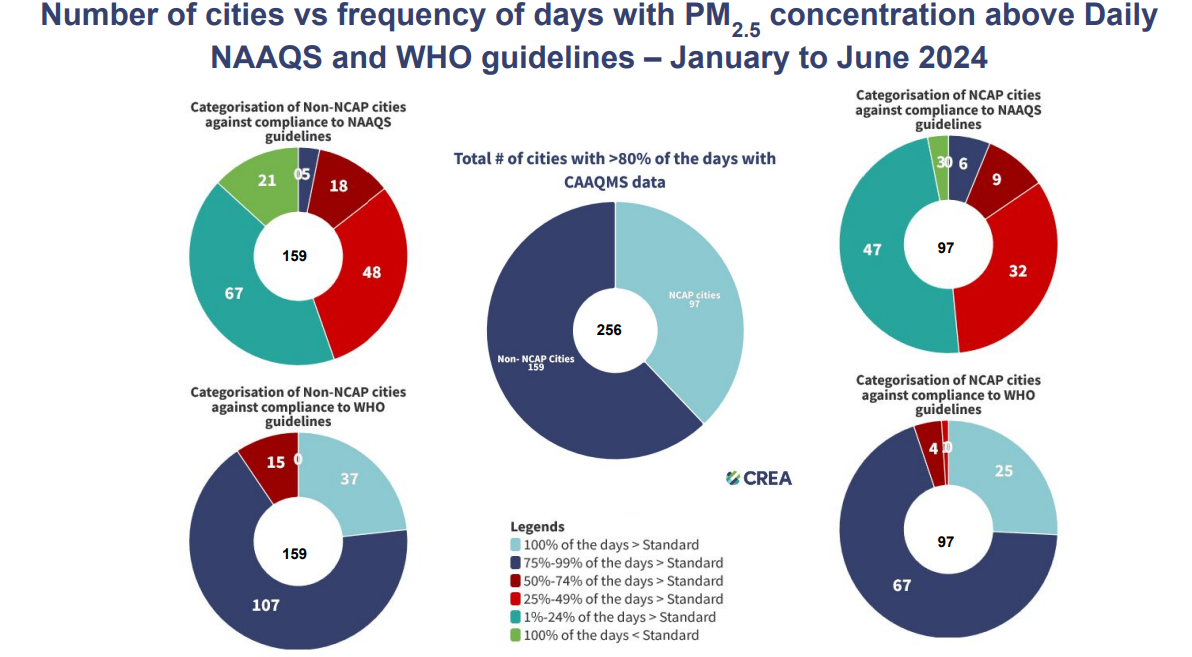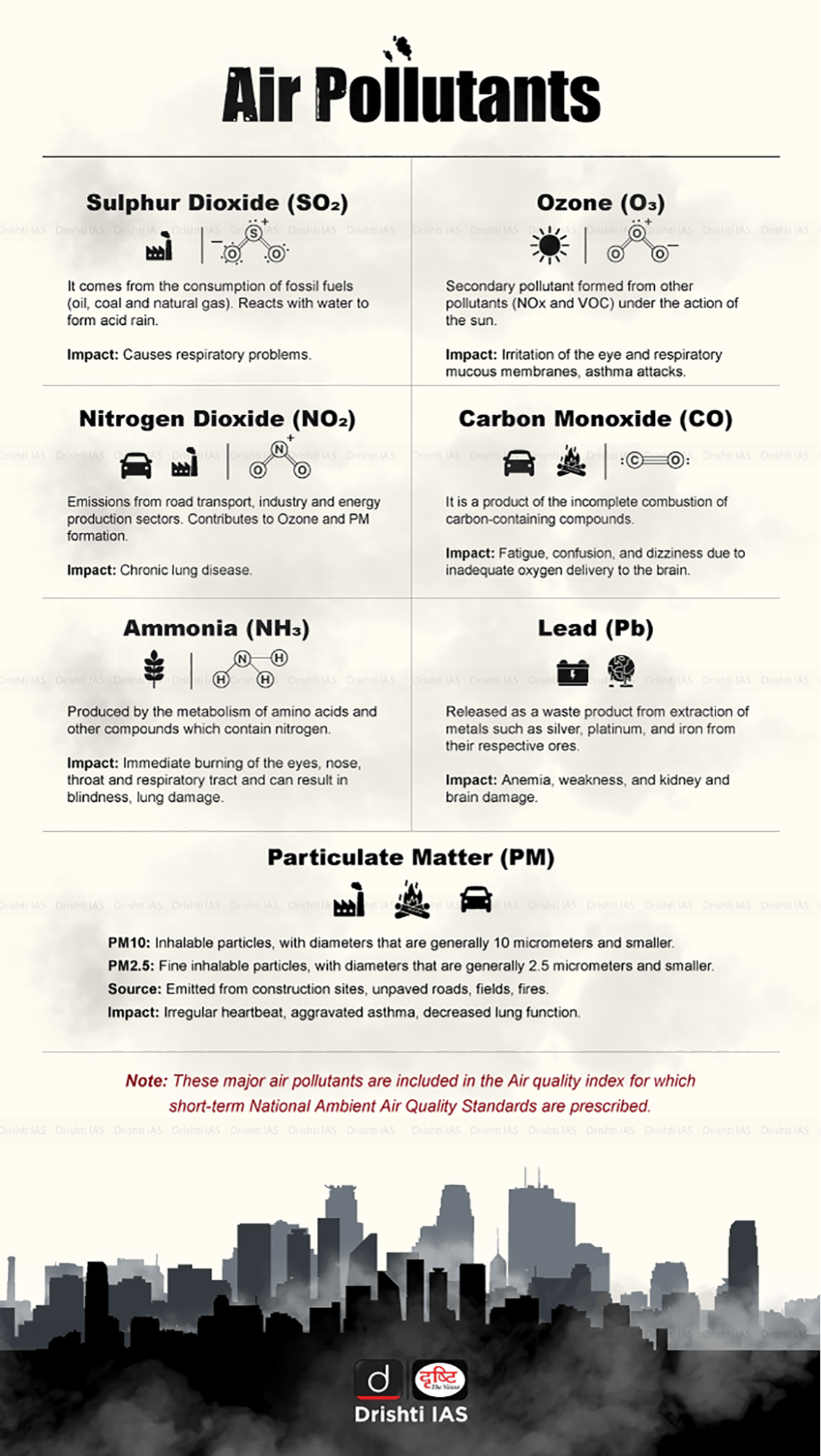Important Facts For Prelims
Mid-Year Air Quality Assessment for India: CREA
- 23 Jul 2024
- 5 min read
Why in News?
Recently, the mid-year air quality assessment for India by the Centre for Research on Energy and Clean Air (CREA), covering the period from January to June 2024, provides a comprehensive overview of the nation's air pollution levels.
- This report highlights the severity and distribution of air pollution across Indian cities, emphasising the importance of stringent measures to combat this environmental crisis.
What are the Key Highlights of the Reports?
- Key Highlights:
- Byrnihat, located on the Assam-Meghalaya border, emerged as the most polluted city in India, with an average PM2.5 concentration of 140 µg/m³(Micrograms per Cubic Metre).
- Among India's top 10 polluted cities, three were in Haryana, two each in Rajasthan and Uttar Pradesh, and one each in Delhi, Assam, and Bihar.
- Delhi ranked as the 3rd most polluted city, with PM2.5 levels at 102 µg/m³, exceeding the National Ambient Air Quality Standards (NAAQS) and World Health Organization (WHO) guidelines.
- Out of 256 cities monitored, 163 exceeded the annual NAAQS (40 µg/m³), while all exceeded the WHO standard (5 µg/m³).
- Among the 97 National Clean Air Programme (NCAP) cities, 63 exceeded the NAAQS.
- Only 63 out of 163 cities exceeding the NAAQS are part of the NCAP, leaving 100 cities without action plans to reduce air pollution.
- The top 10 most polluted cities were spread across 16 states and union territories, indicating the widespread nature of air pollution in India.
- Six new Continuous Ambient Air Quality Monitoring Stations (CAAQMS) were added, increasing the total to 545.
- Karnataka and Maharashtra had the highest number of cities under the "Good" and "Satisfactory" categories, while Bihar had the most cities in the "Moderate" category.
- Implications:
- The high PM2.5 levels in Byrnihat and Delhi underscore the urgent need for localised pollution control measures.
- The prevalence of pollution in states like Haryana and Rajasthan calls for coordinated regional efforts to tackle air quality issues.
- The fact that 100 cities exceeding the NAAQS are not covered under the NCAP highlights a significant gap in India's air quality management framework.
- Expanding the NCAP to include these cities is crucial for comprehensive air pollution control.
- Chronic exposure to high levels of PM2.5 has severe health implications, including respiratory and cardiovascular diseases.
- The report's findings stress the need for public health interventions and awareness programs.
- The increase in CAAQMS is a positive step, but the data gaps and non-operational stations highlight the need for enhanced monitoring infrastructure and maintenance.
- The high PM2.5 levels in Byrnihat and Delhi underscore the urgent need for localised pollution control measures.
- Policy Recommendations: Strengthening emission standards, promoting green technologies, and enhancing public transportation can significantly reduce pollution levels.
- Community participation and stringent enforcement of environmental laws are essential for sustainable air quality improvements.
Initiatives Taken for Controlling Air Pollution
- National Clean Air Programme (NCAP)
- Bharat Stage Emission Standards
- Solid Waste Management Rules,2016
- System of Air Quality and Weather Forecasting and Research (SAFAR) Portal
- Air Quality Index
- Graded Response Action Plan
- National Air Quality Monitoring Programme (NAMP)
- Commission for Air Quality Management
UPSC Civil Services Examination, Previous Year Question (PYQ)
Prelims:
Q. In the cities of our country, which among the following atmospheric gases are normally considered in calculating the value of the Air Quality Index? (2016)
- Carbon dioxide
- Carbon monoxide
- Nitrogen dioxide
- Sulphur dioxide
- Methane
Select the correct answer using the code given below:
(a) 1, 2 and 3 only
(b) 2, 3 and 4 only
(c) 1, 4 and 5 only
(d) 1, 2, 3, 4 and 5
Ans: (b)
Mains
Q. Describe the key points of the revised Global Air Quality Guidelines (AQGs) recently released by the World Health Organisation (WHO). How are these different from its last update in 2005? What changes in India’s National Clean Air Programme are required to achieve revised standards? (2021)







